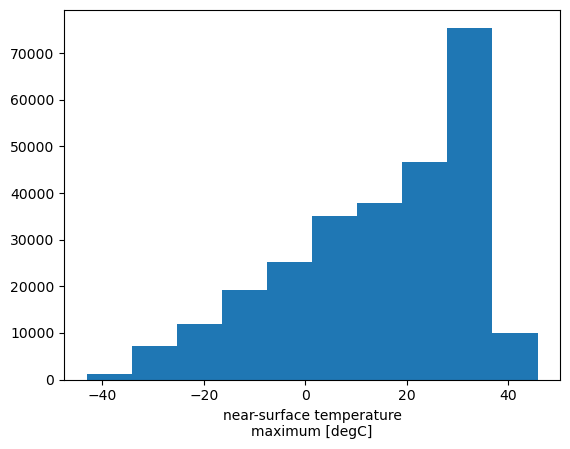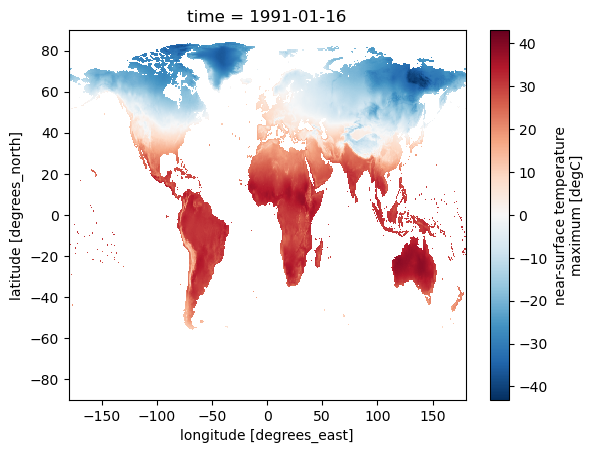cru-x0.25 Example#
Dimensions#
The CRU data has the following dimensions:
time (datetime64[ns]) - The time dimension for the data, monthly resolution.
lat (float64) - The latitude dimension for the data, 0.5° resolution.
lon (float64) - The longitude dimension for the data, 0.5° resolution.
bnds (int64) - The bounds dimension for the data, [0, 1] for each coordinate.
Data variables are organized with respect to those dimensions and can be queried by index, or by dimension.
Example Data#
In the following section, we explore some sample data from the CRU dataset.
Reading the .nc file#
We use xarray, to read in the .nc file as an xarray.Dataset object.
import xarray as xr
data = xr.open_dataset("../climatology-tasmax-seasonal-mean_cru-x0.5_cru-ts4.07-historical_climatology_mean_1991-2020.nc")
Examining the data#
We can examine the data by printing the xarray.Dataset object.
Specifically, we can see the dimensions, coordinates, and data variables.
Further examination of the data can be done by viewing an individual coordinate, data variable, or the attributes of the dataset.
<xarray.Dataset>
Dimensions: (time: 4, lat: 360, lon: 720, bnds: 2)
Coordinates:
* time (time) datetime64[ns] 1991-01-16 ... 19...
* lat (lat) float32 -89.75 -89.25 ... 89.75
* lon (lon) float32 -179.8 -179.2 ... 179.8
* bnds (bnds) int32 0 1
Data variables:
climatology-tasmax-seasonal-mean (time, lat, lon) float32 ...
lon_bnds (lon, bnds) float64 ...
lat_bnds (lat, bnds) float64 ...
Attributes: (12/23)
wb_truncation_label: 2
wb_grid_label: x0.5
wb_period_label: 1991-2020
wb_percentile_label: mean
wb_type_label: climatology
wb_model_label: cru
... ...
institution: Data held at British Atmospheric Data Centre, RAL,...
source: Run ID = 2304141047. Data generated from:TMX deriv...
history: Fri 14 Apr 16:38:44 BST 2023 : User f098 : Program...
references: Information on the data is available at http://bad...
comment: Access to these data is available to any registere...
contact: support@ceda.ac.ukdata['time']
<xarray.DataArray 'time' (time: 4)>
array(['1991-01-16T00:00:00.000000000', '1991-04-16T00:00:00.000000000',
'1991-07-16T00:00:00.000000000', '1991-10-16T00:00:00.000000000'],
dtype='datetime64[ns]')
Coordinates:
* time (time) datetime64[ns] 1991-01-16 1991-04-16 1991-07-16 1991-10-16
Attributes:
typeConversion_op_ncl: double converted to float
long_name: 12 months of a climatological year
axis: T
standard_name: 12 months of a climatological year
climatology_period: 1991-2020data['lon_bnds']
<xarray.DataArray 'lon_bnds' (lon: 720, bnds: 2)>
[1440 values with dtype=float64]
Coordinates:
* lon (lon) float32 -179.8 -179.2 -178.8 -178.2 ... 178.8 179.2 179.8
* bnds (bnds) int32 0 1
Attributes:
long_name: longitude boundsdata.attrs
{'wb_truncation_label': 2,
'wb_grid_label': 'x0.5',
'wb_period_label': '1991-2020',
'wb_percentile_label': 'mean',
'wb_type_label': 'climatology',
'wb_model_label': 'cru',
'wb_variant_label': 'ts4.07',
'wb_scenario_label': 'historical',
'wb_statistic_label': 'mean',
'wb_aggregation_label': 'seasonal',
'wb_variable_label': 'tasmax',
'wb_product_label': 'climatology',
'wb_collection_label': 'cru-x0.5',
'wb': ' \nwb_access_citation = Please acknowledge data source as :\n Climatic Research Unit (University of East Anglia) and Met Office\n accessed through: World Bank Climate Change Knowledge Portal : https://climateknowledgeportal.worldbank.org \nwb_data_license_comment = data available under UK Open Government License: https://www.nationalarchives.gov.uk/doc/open-government-licence/version/3/\nwb_data_comment = Processed CRU data by WB; RAW-data contact: support@ceda.ac.uk\nwb_scientific_reference = Harris, I., Osborn, T.J., Jones, P. et al.\n Version 4 of the CRU TS monthly high-resolution gridded multivariate climate dataset.\n Sci Data 7, 109 (2020). https://doi.org/10.1038/s41597-020-0453-3\nwb_author = Dr. Caspar M Ammann, Climate Strategies, ammann@climatestrategies.com',
'wb_OBS': ' \nwb_creation_date = Fri Sep 1 02:32:28 PM MDT 2023\nwb_OBS_version = 2.0 (summer 2022)',
'Conventions': 'CF-1.4',
'title': 'CRU TS4.07 Maximum Temperature',
'institution': 'Data held at British Atmospheric Data Centre, RAL, UK.',
'source': 'Run ID = 2304141047. Data generated from:TMX derived from gridded TMP & DTR absolutes, DTR in turn derived from tmn.2304141039.dtb, tmx.2304141039.dtb',
'history': 'Fri 14 Apr 16:38:44 BST 2023 : User f098 : Program makegridsauto.for called by update.for',
'references': 'Information on the data is available at http://badc.nerc.ac.uk/data/cru/',
'comment': 'Access to these data is available to any registered CEDA user.',
'contact': 'support@ceda.ac.uk'}
Visualizing the data#
We can visualize the primary data variable in the example dataset, climatology-tasmax-seasonal-mean (if matplotlib is installed), by using the built-in .plot() method of the xarray.DataArray object.
If we just call the .plot() method, we get a default plot of the data, which in this case reduces the dimensionality of the data from 3-D (time, lat, lon) to 1-D, by generating a bar plot of the mean value of the data variable over the entire time period for each latitude and longitude.
# visualize the data
data['climatology-tasmax-seasonal-mean'].plot()
(array([ 1161., 7122., 11847., 19200., 25246., 35081., 37935., 46660.,
75466., 9962.]),
array([-43.06625748, -34.18603897, -25.30581665, -16.42559814,
-7.54537725, 1.33484268, 10.2150631 , 19.09528351,
27.97550201, 36.85572433, 45.73594284]),
<BarContainer object of 10 artists>)

If we want to view the data as a 2-D surface plotted at a specific instance in time, we can use the .plot() method to specify the time index we want to plot.
Because we are working with a .nc file that has been loaded as an xarray.Dataset object, we can use the .sel() method to select the time index we want to plot directly, we do not need to calculate or search for the index value.
# surface plot of the data
data['climatology-tasmax-seasonal-mean'].sel(time='1991-01-16').plot()
<matplotlib.collections.QuadMesh at 0x7f98fd71b320>

